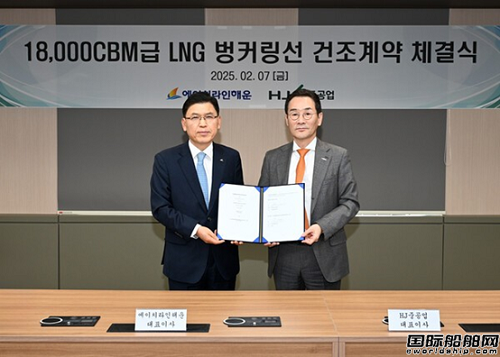
The most advanced and efficient ship type! HJ Heavy Industries receives an order for one LNG refueling vessel

Recently, South Korean HJ Heavy Industries (formerly Hanjin Heavy Industries) signed a construction contract with its own shipowner H-LINE Shipping for an 18000 cubic meter LNG bunkering vessel, with a contract amount of 127.1 billion Korean won (approximately 87.66 million US dollars, 640 million yuan). This is also the first new ship order undertaken by HJ Heavy Industry this year.
The ship has a total length of 144 meters, a width of 25.2 meters, and a depth of 12.8 meters. It can provide up to 18000 cubic meters of LNG fuel at a time and will be equipped with two independent LNG pressure storage tanks certified by the International Maritime Organization (IMO). It will also use an advanced dual fuel (LNG+marine light oil) power system, which can use both LNG and traditional marine diesel, improving the ship's maneuverability and navigation efficiency while effectively reducing carbon emissions.
It is worth mentioning that in order to prevent ship ballast water from disrupting the marine ecosystem, the 7500 cubic meter LNG refueling ship developed by HJ Heavy Industry is a "no ballast water ship (NOBS)" that can navigate without injecting or discharging ballast water. It does not need to carry other ballast water treatment devices, which is not only environmentally friendly but also saves construction and navigation costs. It is considered to be the most advanced and efficient LNG refueling ship.
LNG powered ships usually use onshore LNG storage tanks to provide fuel. If LNG refueling ships are used, it means that LNG fuel can be replenished at sea without docking. Therefore, LNG refueling ships are called "floating offshore refueling stations".
HJ Heavy Industries is the world's first shipping company in South Korea to undertake LNG refueling ship orders. In 2014, the company undertook an order for two 5100 cubic meter LNG bunkering ships from Japan Post (NYK) for a total amount of $100 million. This type of ship has a total LNG cargo hold capacity of 5100 cubic meters, equipped with dual fuel engines. It is 107.6 meters long, 18.4 meters wide, and has a total tonnage of 7403. After delivery in February 2017, it was deployed at the Zeebrugge port in Belgium to provide refueling services for ships using LNG as fuel sailing in the Nordic region.
After the 5100 cubic meter LNG bunkering ship, HJ Heavy Industries has developed a 7500 cubic meter LNG bunkering ship and obtained the principle recognition (AiP) certificate issued by Lloyd's Register (LR) in May 2023.
As the world enters the era of decarbonization, LNG has attracted much attention as an environmentally friendly fuel, and the demand for LNG refueling continues to increase. Singapore based marine fuel supplier Total Energies Marine Fuels predicts that global LNG refueling demand will increase from 400000 tons in 2017 to 10 million tons by 2025.
HJ Heavy Industries representative director Liu Xiangtie said, "With the increase in global LNG demand and supply, the LNG refueling ship market will continue to grow. The company will be committed to accumulating environmentally friendly and high value-added shipbuilding technology, building a renowned shipbuilding brand, and ensuring super competitive advantage in the market
In 2024, HJ Heavy Industry received a total of 1.75 trillion Korean won (approximately 1.29 billion US dollars, 9.2 billion yuan) in orders in the commercial and special vessels (military ships) business, setting a historical high. This represents a 150% increase from the order amount in 2022 and a 300% increase from 2023.
Including the latest orders, Clarkson's data shows that HJ Heavy Industries currently holds a total of 12 orders of 995800 deadweight tons, including 11 container ships and 1 LNG refueling ship, with delivery scheduled for 2027.
Related News
